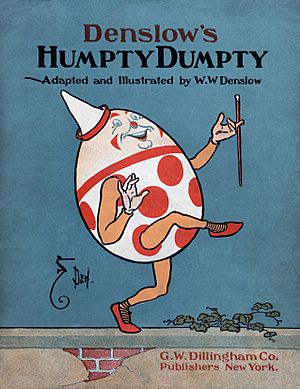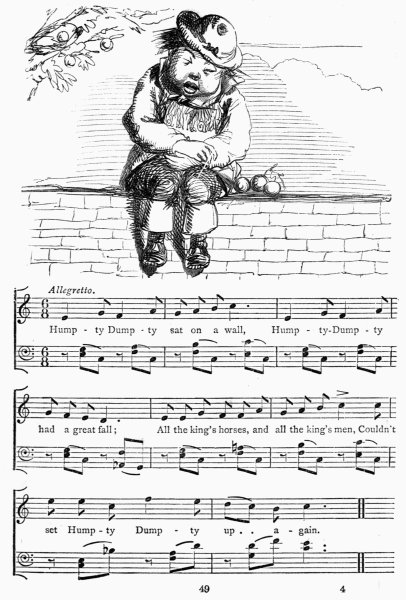Humpty Dumpty facts for kids
Quick facts for kids "Humpty Dumpty" |
|
|---|---|

Illustration by W. W. Denslow, 1904
|
|
| Nursery rhyme | |
| Published | 1797 |
Humpty Dumpty is a famous character from an English nursery rhyme. He is one of the best-known characters in the English-speaking world. People usually imagine him as a large egg that looks like a person, even though the rhyme doesn't actually say he is an egg.
The first known versions of the rhyme appeared in England in the late 1700s. The tune we know today was first written down in 1870 by James William Elliott in his book National Nursery Rhymes and Nursery Songs. No one is completely sure where the rhyme came from, but there are many ideas about its original meaning.
Humpty Dumpty became very popular in the United States thanks to actor George L. Fox. He starred in a musical show called Humpty Dumpty on Broadway from 1868 to 1869. This show ran for 483 performances, making it the longest-running Broadway show for a while. Humpty Dumpty also appears in many books and stories, especially in Lewis Carroll's 1871 book Through the Looking-Glass. In this book, he is clearly shown as an egg.
Contents
Humpty Dumpty: Rhyme and Music
The Humpty Dumpty rhyme is one of the most famous in the English language. The words most people know today were commonly used by 1954:
Humpty Dumpty sat on a wall,
Humpty Dumpty had a great fall.
All the king's horses and all the king's men
Couldn't put Humpty together again.
This rhyme has four lines, which is called a quatrain. The end of the first two lines rhyme with each other, and the end of the last two lines rhyme with each other (AABB pattern). It also has a special rhythm called trochaic metre, which is common in many nursery rhymes.
The music for the rhyme was first written down by James William Elliott in his book National Nursery Rhymes and Nursery Songs in 1870. You can see the musical notes below:
<score %vorbis="1"%%T257066%> \new Staff << \clef treble \key bes \major { \time 6/8 \partial 2. \relative d' { d4 f8 es4 g8 | f8 g a bes4. | d,4 f8 es4 g8 | f8 d bes c4. \bar"" \break d8 d f es es g | f8 g a bes4. | d8 d bes es es d | c8 bes a bes4. \bar"" \break } } %\new Lyrics \lyricmode { %} >> \layout { indent = #0 } \midi { \tempo 4. = 56 } </score>
The History of Humpty Dumpty

The very first known version of the rhyme was printed in Samuel Arnold's Juvenile Amusements in 1797. Its words were a bit different:
Humpty Dumpty sat on a wall,
Humpty Dumpty had a great fall.
Four-score Men and Four-score more,
Could not make Humpty Dumpty where he was before.
In 1843, a writer named William Carey Richards mentioned the poem. He said that when he was five years old, this poem was given as a riddle. He also said that "Humpty-dumpty" was a word for an egg. This shows that people already thought of Humpty Dumpty as an egg a long time ago.
The rhyme was often used as a riddle. The trick was that "humpty dumpty" also used to be slang for a short, clumsy person. So, the riddle played on the idea that a clumsy person falling might not be badly hurt, but an egg certainly would be! Today, it's not really a riddle anymore because everyone knows the answer.
Similar riddles exist in other languages. For example, there's "Boule Boule" in French, "Lille Trille" in Swedish and Norwegian, and "Runtzelken-Puntzelken" in parts of Germany. However, none of them are as famous as Humpty Dumpty is in English.
Humpty Dumpty in Lewis Carroll's Through the Looking-Glass
Humpty Dumpty is a character in Lewis Carroll's book Through the Looking-Glass, published in 1871. This book is a sequel to Alice in Wonderland.
In the story, Alice tells Humpty Dumpty that he looks "exactly like an egg." Humpty Dumpty finds this comment "very provoking." They have a funny conversation about words and their meanings. Humpty Dumpty says his name means his shape. Later, he famously tells Alice:
"When I use a word," Humpty Dumpty said, in rather a scornful tone, "it means just what I choose it to mean—neither more nor less."
"The question is," said Alice, "whether you can make words mean so many different things."
"The question is," said Humpty Dumpty, "which is to be master—that's all."
This part of the story shows Humpty Dumpty believes he can make words mean whatever he wants them to mean.
Humpty Dumpty also tells Alice that he finds faces hard to recognize. He says:
"Your face is the same as everybody has—the two eyes,—" (marking their places in the air with his thumb) "nose in the middle, mouth under. It's always the same. Now if you had the two eyes on the same side of the nose, for instance—or the mouth at the top—that would be some help."
This suggests he has trouble telling people apart by their faces.
Humpty Dumpty in Books and Movies
The idea of Humpty Dumpty's fall and inability to be put back together has inspired many other stories.
Robert Penn Warren's 1946 American novel All the King's Men tells the story of a politician named Willie Stark. His rise to power and his eventual downfall are similar to Humpty Dumpty's story. This book won a famous award called the Pulitzer Prize and was made into a movie twice.
The title All the President's Men was also used for a book about the Watergate scandal. This scandal involved a U.S. President's staff. The title suggests that once the scandal became public, the damage could not be fixed, just like Humpty Dumpty couldn't be put back together. This book was also made into a movie in 1976, starring Robert Redford and Dustin Hoffman.
Humpty Dumpty and Science
Humpty Dumpty's story can help explain a science concept called the second law of thermodynamics. This law talks about something called entropy. Entropy is a way to measure the "disorder" or randomness in a system. The more spread out or mixed up things are, the higher the entropy.
When Humpty Dumpty falls and breaks, he becomes much more "disordered" than when he was whole. The second law of thermodynamics says that in a closed system, entropy (disorder) tends to increase over time. It's very, very unlikely for a broken egg to put itself back together. This is because it would mean going from a high-entropy (disordered) state back to a low-entropy (ordered) state, which usually doesn't happen naturally. So, Humpty Dumpty's fall shows how things tend to become more disordered and are hard to put back together.
Images for kids
-
Humpty Dumpty, shown as a riddle with answer, in a 1902 Mother Goose story book by William Wallace Denslow
-
Poster advertising a pantomime version at the Olympic Theatre in New York 1868, starring George L. Fox
See also
 In Spanish: Humpty Dumpty para niños
In Spanish: Humpty Dumpty para niños




